This article has multiple issues. Please help improve it or discuss these issues on the talk page . (Learn how and when to remove these template messages)
|
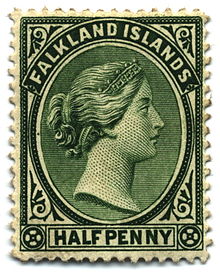
This is a survey of the postage stamps and postal history of the Falkland Islands .
This article has multiple issues. Please help improve it or discuss these issues on the talk page . (Learn how and when to remove these template messages)
|

This is a survey of the postage stamps and postal history of the Falkland Islands .
Early mail service depended on occasional calls by ships connecting to the Brazil packet via Montevideo; the earliest recorded letter dates from 15 February 1800. From 1852 to 1880 a schooner (either a government boat or a contractor) called about every two months.
In October 1877, the Secretary of State of the Colonial Office, the Earl of Carnarvon began the process of application for the Falkland Islands to join the General Postal Union (renamed Universal Postal Union in 1879). No sooner than the Falklands had joined the GPU; an announcement was made that the postage rates would be reduced from 6d per ½ ounce to 4d per ½ ounce. [1]
Before 17 July 1861 postage costs could not be prepaid, and from 1869 prepaid franks are known, used by the local postmaster.
The first stamps, 1d and 6d values featuring the profile of Queen Victoria, were issued 19 June 1878. Unusually for a British colony, the first stamps were not on watermarked paper, but this was rectified in 1883. Additional values of this design appeared from time to time until 1902.
In 1880, carriage of mail was made mandatory for any ship calling at Stanley, and regular service was contracted to the German Kosmos Line, which operated steamships on a route from Hamburg to Callao, Peru. The first post office opened in Stanley in 1887.
On 1 January 1891 a need for 1/2d stamps resulted in the authorization of bisection and surcharge of existing 1d stamps. 1/2d stamps arrived in September, but the bisects were allowed until 11 January 1892.
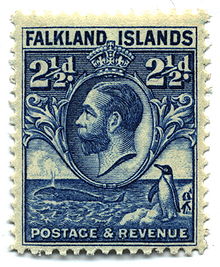
In 1900, the Pacific Steam Navigation Company got the contract, which operated until 1914, when the opening of the Panama Canal made Cape Horn roundings unnecessary, and regular mail service to the Falklands was not resumed until 1927.
In 1904 new stamps of the same general design, but depicting Edward VII, were issued, and likewise after 1912 for George V. Shortages of dyes due to World War I led to considerable color variations in the wartime printings of George V stamps.
The 2d purple stamp was surcharged 21⁄2d in 1928 for use on the island of South Georgia only during a stamp shortage.
In 1929 the first pictorial design appeared, featuring small images of a whale and penguins beneath the profile of George V. This was followed up by the much-admired centennial issue of 1933, a series of 12 stamps featuring local scenes and wildlife evocatively rendered; a full set is today priced at about US$3,000.

Starting in the 1930s, the Falklands took part of the omnibus issues of the Empire; the Silver Jubilee issue of 1935, Coronation issue for George VI in 1937, and so forth. The new king also meant a need for a new definitive series, which came out in 1938 and featured scenes, wildlife, and ships, though in a somewhat plainer design than the pictorials of 1933.
A last definitive series for George VI appeared in 1952. Of the 14 stamps of the issue, six were re-issued between 1955 and 1957 with a portrait of Elizabeth II. The next definitive series did not come out until 1960, the 15 values depicting various native birds.
In 1964, a series of four stamps commemorating the 50th anniversary of the Battle of the Falkland Islands became notable for the HMS Glasgow error, in which the wrong warship was printed on a few of the six-pence value.
During the Falklands War of 1982, occupied islands used stamps of Argentina, and postmarks with the wording "Islas Malvinas". Since that time, a British garrison has been maintained; while forces mail to home is free, mail to other destinations requires postage franked with British stamps, and as of 2003 was cancelled with two intertwined circles saying "Falkland Islands BFPO 655 Post Office".

In 2003, the Islands were given their own UK postcode, FIQQ 1ZZ. This was in response to complaints that mail to the Falklands was being sent to the wrong destination (usually either Falkland in Fife, where postcodes have the letters 'FK', or to the Faroe Islands). The introduction of the postcode, valid for all local addresses, also helped Islanders to fill in mail order forms online, many of which insisted on a valid ZIP or postal code. [2]
On 1 August 2014 the Falkland Islands postal and philatelic bureau services were privatised by a decision of the Falkland Islands Government as the Falklands Post Service Ltd. [3]

The postal and philatelic history of Canada concerns postage of the territories which have formed Canada. Before Canadian confederation, the colonies of British Columbia and Vancouver Island, Prince Edward Island, Nova Scotia, New Brunswick and Newfoundland issued stamps in their own names. The postal history falls into four major periods: French control (1604–1763), British control (1763–1841), colonial government control (1841–1867), and Canada, since 1867.

Indian postal systems for efficient military and governmental communications had developed long before the arrival of Europeans. When the Portuguese, Dutch, French, Danish and British conquered the Marathas who had already defeated the Mughals, their postal systems existed alongside those of many somewhat independent states. The British East India Company gradually annexed the other powers on the sub-continent and brought into existence a British administrative system over most of modern-day India, with a need to establish and maintain both official and commercial mail systems.

Postage stamps and postal history of Great Britain surveys postal history from the United Kingdom and the postage stamps issued by that country and its various historical territories until the present day.

This is an overview of the postage stamps and postal history of Australia.

This is a survey of the postage stamps and postal history of the Gilbert and Ellice Islands.

In philately, the denomination is the "inscribed value of a stamp".
This is a survey of the postage stamps and postal history of Macau.

This is a survey of the postage stamps and postal history of Vanuatu, formerly known as the New Hebrides, an island group in the South Pacific. Between 1906 and 1980, the islands were an Anglo-French Condominium.
A semi-postal stamp or semipostal stamp, also known as a charity stamp, is a postage stamp issued to raise money for a particular purpose and sold at a premium over the postal value. Typically the stamp shows two denominations separated by a plus sign, but in many cases the only denomination shown is for the postage rate, and the postal customer simply pays the higher price when purchasing the stamps.

The postage stamps of Ireland are issued by the postal operator of the independent Irish state. Ireland was part of the United Kingdom of Great Britain and Ireland when the world's first postage stamps were issued in 1840. These stamps, and all subsequent British issues, were used throughout Ireland until the new Irish Government assumed power in 1922. Beginning on 17 February 1922, existing British stamps were overprinted with Irish text to provide some definitives until separate Irish issues became available within the new Irish Free State. Following the overprints, a regular series of definitive stamps was produced by the new Department of Posts and Telegraphs, using domestic designs. These definitives were issued on 6 December 1922, the day that the Irish Free State officially came into existence; the first was a 2d stamp, depicting a map of Ireland. Since then new images, and additional values as needed, have produced nine definitive series of different designs.

The postal history of Malta began in the early modern period, when pre-adhesive mail was delivered to foreign destinations by privately owned ships for a fee. The earliest known letter from Malta, sent during the rule of the Order of St John, is dated 1532. The first formal postal service on the islands was established by the Order in 1708, with the post office being located at the Casa del Commun Tesoro in Valletta. The first postal markings on mail appeared later on in the 18th century.
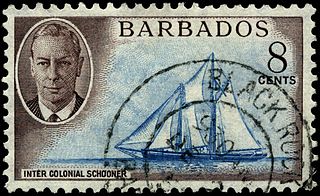
This is a survey of the postage stamps and postal history of Barbados.
Belize started as the colony of British Honduras, formally established in the 17th century but disputed through the 18th century.

This is a survey of the postage stamps and postal history of Dominica, an island nation in the Caribbean Sea. Claimed by France in the 17th century, it was later awarded to Great Britain, becoming independent in 1978.

St. Lucia a former British dependency in the Windward Islands began using stamps in 1860. It achieved Associated Statehood on 1 March 1967. In 1979, it gained independence.

This is a survey of the postage stamps and postal history of Saint Helena.

This is a survey of the postage stamps and postal history of Sierra Leone.
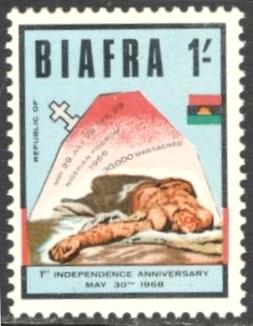
This is a survey of the postage stamps and postal history of Biafra.
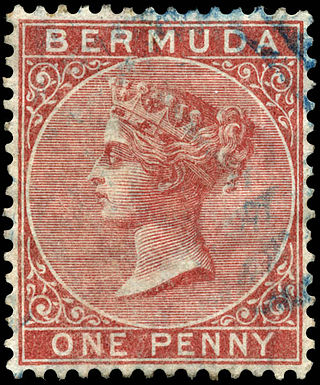
Bermuda, a group of islands in the North Atlantic Ocean, was previously uninhabited when the British established a settlement in 1612.

The Melita issue is a series of dual-purpose postage and revenue stamps issued by the Crown Colony of Malta between 1922 and 1926, depicting the national personification Melita. They were commemorative stamps since they celebrated the islands' new status as a self-governing colony following a new constitution in 1921, but also a definitive issue intended for regular use over an extended period of time.